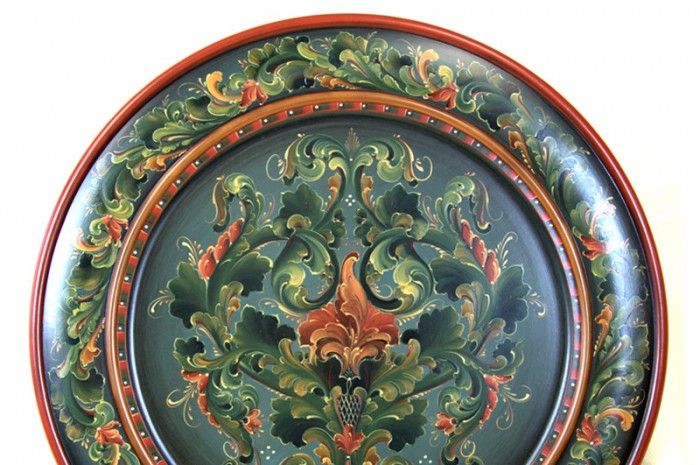
Rosemaling is a decorative folk art that originated in Norway. At the height of its’ popularity, from the late 17th century to the late 19th century, itinerant artists of the time would travel from region to region painting churches, homes, and furnishings for income or room and board. Common design elements used in Rosemaling include C and S strokes, scrolls, flowing lines, floral elements, subtle and vibrant colors, dots and teardrops, cross-hatching, and two-dimensional interpretations of three-dimensional wood carving. For the most part these were untrained rural artists without the restrictions or requirements of the professional Artists Guilds of the day forced upon them. This freed them to interpret their work in their own unique ways and led to the formation of regional styles. As they traveled to support themselves they took their own individual styles to surrounding areas of Norway which aided the spread of the art form.
Styles of Rosemaling
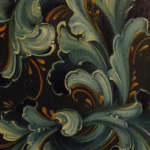 Gudbrandsdal Greatly imitating the woodcarving of the time, the predominant scrolls and leaves of Gudbrandsdal are painted to show great depth and dimension. The portrayal of the gradations of light to dark are the hallmark of this style. The designs can be either symmetrical or asymmetrical. If flowers are present in the designs they would often be presented as the stylized tulips, 6-8 petal roses or the buds & berries found in the acanthus carving. This style has a quiet elegance and dramatic beauty.
Gudbrandsdal Greatly imitating the woodcarving of the time, the predominant scrolls and leaves of Gudbrandsdal are painted to show great depth and dimension. The portrayal of the gradations of light to dark are the hallmark of this style. The designs can be either symmetrical or asymmetrical. If flowers are present in the designs they would often be presented as the stylized tulips, 6-8 petal roses or the buds & berries found in the acanthus carving. This style has a quiet elegance and dramatic beauty.
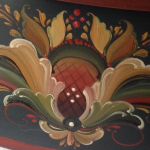 Hallingdal The striking feature of Hallingdal is a central flower around which all things gather symmetrically. Scrolls and flowers are painted with vibrant bold colors. Dimension and depth are created by the adjacent placement of strongly contrasting hues. Minimal shading is used, instead light and dark line work used on opposite sides of the element contribute to creating depth. Leaves, teardrops and additional embellishments surround the elements and are painted in dark line work.
Hallingdal The striking feature of Hallingdal is a central flower around which all things gather symmetrically. Scrolls and flowers are painted with vibrant bold colors. Dimension and depth are created by the adjacent placement of strongly contrasting hues. Minimal shading is used, instead light and dark line work used on opposite sides of the element contribute to creating depth. Leaves, teardrops and additional embellishments surround the elements and are painted in dark line work.
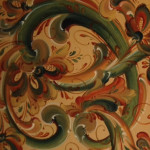 Telemark The asymmetrical Telemark style is defined by the signature C-scroll which forms the framework from which all other elements in the design grow. This C shaped scroll grows from a root and becomes supported by intertwining C and S shapes which emerge from it. All elements, from the fantasy-like flowers to the elaborate line work and whimsical embellishing detail stem from the root. The flow and movement that are created can be described by words like lyrical, joyful and exuberant.
Telemark The asymmetrical Telemark style is defined by the signature C-scroll which forms the framework from which all other elements in the design grow. This C shaped scroll grows from a root and becomes supported by intertwining C and S shapes which emerge from it. All elements, from the fantasy-like flowers to the elaborate line work and whimsical embellishing detail stem from the root. The flow and movement that are created can be described by words like lyrical, joyful and exuberant.
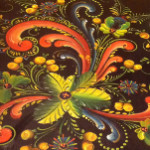 Os Coming from the west cost of Norway the Os style of Rosemaling is distinctively bright and cheerful. Flowers are abstracted and the use of geometric shapes is a hallmark of this style. Leaves have a characteristic use of heavy line-work for veins, and shading is less dimensional. Designs can be symmetrical or asymmetrical. C and S shaped scrolls are found in the Os style and often include elaborate line-work embellishment surrounding them. In character with this style the backgrounds will often be black or white and occasionally either reds, greens or blues.
Os Coming from the west cost of Norway the Os style of Rosemaling is distinctively bright and cheerful. Flowers are abstracted and the use of geometric shapes is a hallmark of this style. Leaves have a characteristic use of heavy line-work for veins, and shading is less dimensional. Designs can be symmetrical or asymmetrical. C and S shaped scrolls are found in the Os style and often include elaborate line-work embellishment surrounding them. In character with this style the backgrounds will often be black or white and occasionally either reds, greens or blues.
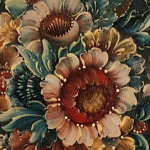 Valdres Flower elements are a predominant feature of Valdres Rosemaling with scrolls taking a secondary role or no part at all. The flowers portrayed in Valdres style are the most representational of nature of all the Rosemaling styles. Figures, buildings and scenery – particularly tone on tone or “chinoiserie” are also classic elements of the Valdres style.
Valdres Flower elements are a predominant feature of Valdres Rosemaling with scrolls taking a secondary role or no part at all. The flowers portrayed in Valdres style are the most representational of nature of all the Rosemaling styles. Figures, buildings and scenery – particularly tone on tone or “chinoiserie” are also classic elements of the Valdres style.
